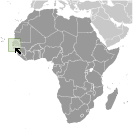World Atlas: Gambia. On this page you can see the map, country flag and many detailed information about the people, history and economy of Gambia.

Here you can find online selected information about the geography, inhabitants, government, economy and history of Gambia. Included are selected statistics, an overview map and the detailed map of Gambia. But let's start with the flag of Gambia here:
Gambia - Overview:
What you should know about Gambia? Let's start with this: The Gambia gained its independence from the UK in 1965. Geographically surrounded by Senegal, it formed a short-lived Confederation of Senegambia between 1982 and 1989. In 1991 the two nations signed a friendship and cooperation treaty, but tensions have flared up intermittently since then. Yahya Jammeh led a military coup in 1994 that overthrew the president and banned political activity. A new constitution and presidential election in 1996, followed by parliamentary balloting in 1997, completed a nominal return to civilian rule. Jammeh was elected president in all subsequent elections including most recently in late 2011. After 22 years of increasingly authoritarian rule, President Jammeh was defeated in free and fair elections in December 2016. Due to The Gambia’s poor human rights record under Jammeh, international development partners had distanced themselves, and substantially reduced aid to the country. These channels may re-open under the administration of President
Geography of Gambia
 Where on the globe is Gambia? The location of this country is Western Africa, bordering the North Atlantic Ocean and Senegal. Total area of Gambia is 11,300 sq km, of which 10,120 sq km is land. So this is quite a small country. How could we describe the terrain of the country? This way: flood plain of the Gambia River flanked by some low hills. The lowest point of Gambia is Atlantic Ocean 0 m, the highest point unnamed elevation 53 m. And the climate is tropical; hot, rainy season (June to November); cooler, dry season (November to May).
Where on the globe is Gambia? The location of this country is Western Africa, bordering the North Atlantic Ocean and Senegal. Total area of Gambia is 11,300 sq km, of which 10,120 sq km is land. So this is quite a small country. How could we describe the terrain of the country? This way: flood plain of the Gambia River flanked by some low hills. The lowest point of Gambia is Atlantic Ocean 0 m, the highest point unnamed elevation 53 m. And the climate is tropical; hot, rainy season (June to November); cooler, dry season (November to May).
Inhabitants of Gambia
Let's take a look how many people live in Gambia. The number is: 2,051,363 (July 2017 est.). So this is not very populous country. Who lives here? Mandinka/Jahanka 34%, Fulani/Tukulur/Lorobo 22.4%, Wolof 12.6%, Jola/Karoninka 10.7%, Serahuleh 6.6%, Serer 3.2%, Manjago 2.1%, Bambara 1%, Creole/Aku Marabout 0.7%, other 0.9%, non-Gambian 5.2%, no answer 0.6% (2013 est.). What are the languages in Gambia? English (official), Mandinka, Wolof, Fula, other indigenous vernaculars. And the religions: Muslim 95.7%, Christian 4.2%, none 0.1%, no response 0.1% (2013 est.). How old are the people in average? 21 years. We have to add that this number is the median - so one half of the people is older than this, one half is younger. And what is their life expectancy (at birth)? This: 65.1 years. Where the people live in Gambia? Here: settlements are found scattered along the Gambia River; the largest communities, including the capital of Banjul, and the country's largest city, Serekunda, are found at the mouth of the Gambia River along the Atlantic coast. The major urban areas of Gambia are: Banjul (capital) 504,000 (2015).
Government and Economy of Gambia
The capital of Gambia is Banjul and the government type presidential republic. Let's take a look at the administrative divisions - 5 regions, 1 city, and 1 municipality; Banjul, Central River, Kanifing, Lower River, North Bank, Upper River, West Coast. Regarding the economy of Gambia, important industrial products are peanuts, fish, hides, tourism, beverages, agricultural machinery assembly, woodworking, metalworking, clothing. Important agricultural products are rice, millet, sorghum, peanuts, corn, sesame, cassava (manioc, tapioca), palm kernels; cattle, sheep, goats. The most important export commodities are peanut products, fish, cotton lint, palm kernels and the most important export partners are Mali 36.3%, Guinea 24.5%, Senegal 12.3%, China 11.7%, Guinea-Bissau 5.8% (2016). The most important import commodities are foodstuffs, manufactures, fuel, machinery and transport equipment and the most important import partners are Cote dIvoire 13%, Brazil 12.3%, China 11%, Belgium 8.6%, India 5.7%, Spain 4.7%, Senegal 4.6% (2016). How rich is Gambia and how rich are people in this country? The most important number here is GDP per capita (PPP): $1,700 (2017 est.). This is a very low number. Let's add that this means Gross Domestic Product per person, which is recalculated with respect to the relative cost of local goods and services. And one more important number - population below poverty line: 48.4% (2010 est.).